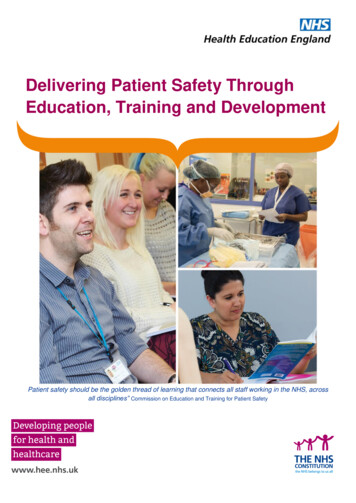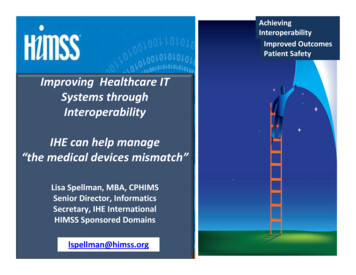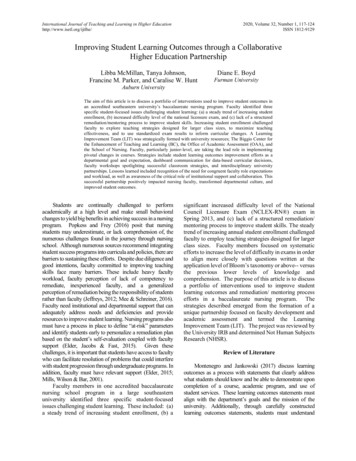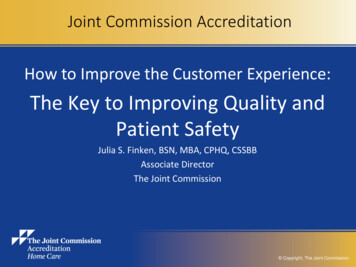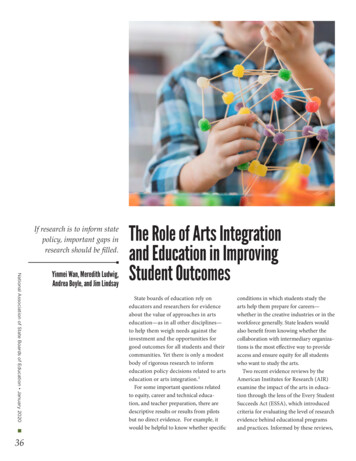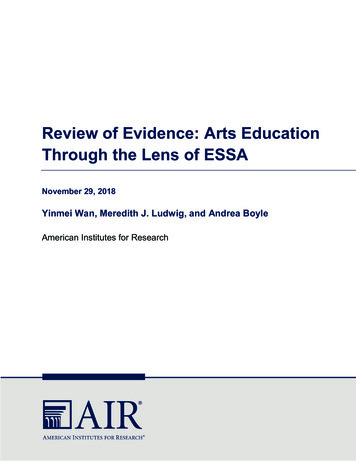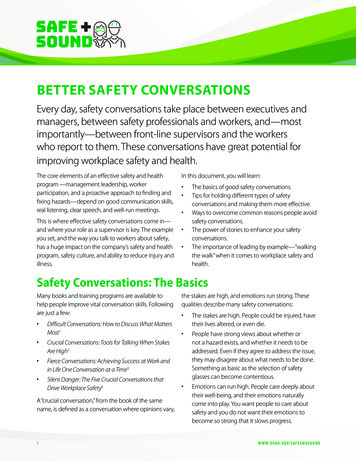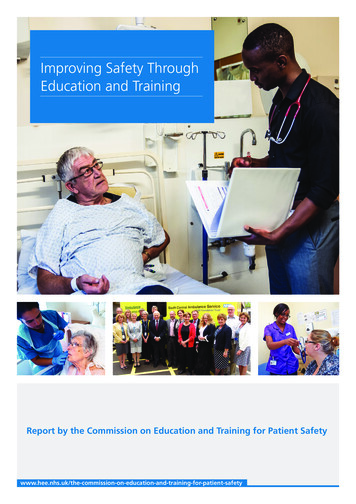
Transcription
Improving Safety ThroughEducation and TrainingReport by the Commission on Education and Training for Patient nd-training-for-patient-safety
The Commission on Education and Training for Patient SafetyContentsForeword. 3Executive summary. 4Our recommendations. 5Introduction. 8The case for change. 9How safe are patients in the NHS?. 9Recent patient safety improvements. 10Making change in partnership with others. 12About this report. 13Creating a culture of shared learning. 15Good practice and learning from incidents is rarely shared across the NHS. 15We need a shared language to talk about patient safety. 18Measuring impact is often neglected. 19The patient at the centre of education and training. 21We need to do more to involve patients. 21The NHS needs to do more to ensure openness when things go wrong. 25Lifelong learning – ensuring that patient safety is a priority from start to finish. 27The importance of empowering learners and staff to be the ‘eyes and ears’ of the NHS. 27 Staff must have protected time for training on patient safety and thatcontinuing professional development should be standardised. 30Leaders also need safety training. 32Delivering education and training for patient safety. 33 Staff and students need to be trained to work in a more integrated NHSand to consider safety in its broadest context. 34Staff and students want inter-professional learning. 38The importance of human factors. 40Students, staff and leaders should know how to manage risk. 42In conclusion. 46Appendix. 48Glossary. 49Acknowledgements. 52References. 542
ForewordForewordSafety in healthcare is everyone’s responsibility and has been a mantra for many years. Despite the rhetoric however,critical incidents that destroy people’s lives sadly continue and their prevalence remains by and large static. Near missesoccur regularly and lessons are rarely learnt or disseminated through the system. This is a universal problem but onethat we believe the NHS is well placed to tackle and if we get it right the NHS could be a world leader.Getting it right involves instilling the right culture from the very beginning of a healthcare worker’s career. Educationand training from undergraduate and apprentice level throughout one’s career can not only embed the right approachto preventing and learning from errors but also keeps the mind receptive to new ideas that could improve safety.Health Education England (HEE) - responsible for the training of all healthcare workers - established the independentCommission on Education and Training for Patient Safety, to review the current status of safety education and trainingfor all learners, including in curricula and workplace learning.We commissioned Imperial College as our academic partner. We sought views from patient groups and both nationaland international safety experts. We travelled the country to observe many new initiatives, took soundings from focusgroups and debated long and hard as to what we felt would make significant and sustained changes to practice, be itin the community, hospital or primary care setting.It was clear to us that major changes are needed in multi-specialty and team working, greater emphasis on humanfactors is required, simulation should become commonplace in all sorts of scenarios and a much more transparent andopen reporting system needs to be established where we move from a blame culture to a learning one.These are just some of our observations and are by no means an exhaustive list. The Commission has made 12recommendations to HEE and the wider system that we believe if fully enacted should make a marked difference toimproving healthcare in this country and indeed beyond. It is now up to HEE to decide how best to implement therecommendations but we would advise strongly that they do so at pace. Improving safety must be our priority and thetime to act is now.We are enormously grateful for the hard work of all Commission members who gave their time freely and abundantly.We were fortunate to have patient representatives on the Commission and we tried at all times to see things throughtheir perspective. We also thank all members of HEE staff, both past and present who have worked diligently toassimilate the multiple diverse views and make this a coherent document.Professor Sir Norman Williams,Chair Commission on Education and Trainingfor Patient SafetySir Keith Pearson,Vice-Chair Commission on Education and Trainingfor Patient Safety3
The Commission on Education and Training for Patient SafetyExecutive summaryThis report is different from the many reports on patientsafety published both for the NHS and internationallyover the last decade. Here, for the first time, the focusis on how education and training interventions canactively improve patient safety. There is a real need for asystematic approach that uses learning tools effectively,both for short term reduction in risk to patients and alsoto build a long-term, sustainable learning environmentwithin healthcare that is centred on patients and on theneed for the safest care possible.This report, produced by the Commission on Educationand Training for Patient Safety sets out its ambition toimprove patient safety through education and trainingand makes a number of recommendations to HealthEducation England (HEE) and the wider system.BackgroundThe energy and pace of change in the NHS is greaterthan ever before. There is a real and palpablecommitment to improving patient safety and widespreadrecognition that education and training is vital inreducing patient harm. Organisations are pioneeringinitiatives and healthcare staff at every level recognisehow they contribute to keeping patients safe. Patientsand staff are demanding improvement, pushing fordeeper, broader, faster change and the government havemade patient safety a priority area.Despite this, an estimated one in 101 patients admittedto NHS hospitals will still experience some kind of patientsafety incident and around half of all incidents arethought to be avoidable.2Patient safety should be a golden thread of learningthat connects all staff working in the NHS, across alldisciplines, from apprentice and undergraduate rightthrough to retirement. The NHS cannot expect to achieveimprovements in patient safety if it is not embeddedwithin education and training and if we cannot safelyallow staff the time away from the workplace to undergotraining. Changing behaviours and outcomes will beimpossible if there continues to be a blame culture whereindividuals are vilified when things go wrong rather thansupported to learn from errors and to look at the systemas a whole. The NHS has to change.4The CommissionThe Commission, supported by Imperial College London,gathered evidence through focus groups, interviews,regional visits and online surveys; from patients and theirfamilies, carers, students and trainees, frontline staffat every level across all settings, healthcare managers,executives, as well as international experts and nationalorganisations. We were told what works, and what doesnot work when it comes to improving patient safetythrough education and training. We saw evidence ofgood educational practice, heard what supports peopleto make improvements and what gets in the way. Weasked people for their ideas on how to improve patientsafety through education and training. This report is theculmination of these months of work.This report aims to shape the future of education andtraining for patient safety in the NHS over the next 10years. Strategic leadership and collaboration acrossthe NHS is vital to ensure all staff have the right skills,knowledge, values and behaviours to ensure patientsafety. This underpins all of our recommendations.“ The NHS shouldcontinually andforever reduce patientharm by embracingwholeheartedly anethic of learning.”Professor Don Berwick
Our recommendationsOur recommendationsEducation and training can break down barriers toproviding safe care, creating an environment where allstaff learn from error, patients are at the centre of care,treated with openness and honesty and where staff aretrained to focus on patient needs. However, the rightworkplace conditions, motivation and opportunity mustalso exist in order to ensure sustained behaviour change.Set out under four broad themes, this report makes a seriesof recommendations that we believe will make the greatestdifference to patient safety both now and in the future.Creating a culture of sharedlearningRecommendation 1Ensure learning from patient safety dataand good practicePatient safety data, including learning from incidents andgood practice case studies, must be made more readilyavailable to those responsible for developing educationand training. The Commission recommends: HEE engages with national partner organisations,employers and those responsible for curricula toensure patient safety data is being shared beyondtraditional professional and institutional boundariesand is being used as an educational resourceHEE works with partner organisations to scale upand replicate good practice training and educationfor patient safety. We suggest sharing good practiceexamples through the forthcoming TechnologyEnhanced Learning (TEL) platform HEE works with NHS Improvement and localpartners to overcome existing barriers and facilitateaccess to locally relevant incident reports for use indevelopment of education and training clinical commissioning groups, NHS England, HEE andother system partners particularly NHS Improvement,to work together to explore the potential fordevelopment of ‘lessons learned’ alerts following apatient safety incident or near miss.Recommendation 2Develop and use a common languageto describe all elements of qualityimprovement science and human factorswith respect to patient safetyThe Commission recommends the development of acommon language, to increase understanding aboutthe relationship between human factors and qualityimprovement science and the importance of integratingthese approaches.Recommendation 3Ensure robust evaluation of education andtraining for patient safetyThe Commission recommends HEE works with partnerorganisations to facilitate the development of anevaluation framework to ensure that all education andtraining for patient safety commissioned in future, iseffectively evaluated using robust models. HEE shouldfacilitate a discussion with major research funders andthose academically active in health education about thisvital and neglected area.5
The Commission on Education and Training for Patient SafetyThe patient at the centre ofeducation and trainingLifelong learning – focussing onsafety from start to finishRecommendation 4Recommendation 6Engage patients, family members, carersand the public in the design and delivery ofeducation and training for patient safetyThe learning environment must support alllearners and staff to raise and respond toconcerns about patient safetyHEE and the relevant regulators of education to ensurethat future education and training emphasises theimportant role of patients, family members and carers inpreventing patient safety incidents and improving patientsafety. Specifically, the Commission recommends:The Commission recommends that HEE works withnational partner organisations and employers to ensurethat the learning environment encourages and supportsstaff, including those learning and those teaching, to raiseand respond to patient safety concerns. HEE uses its levers to ensure that patients and serviceusers are involved in the co-design an
Health Education England (HEE) - responsible for the training of all healthcare workers - established the independent Commission on Education and Training for Patient Safety, to review the current status of safety education and training for all learners, including in curricula and workplace learning. We commissioned Imperial College as our academic partner. We sought views from patient groups .
